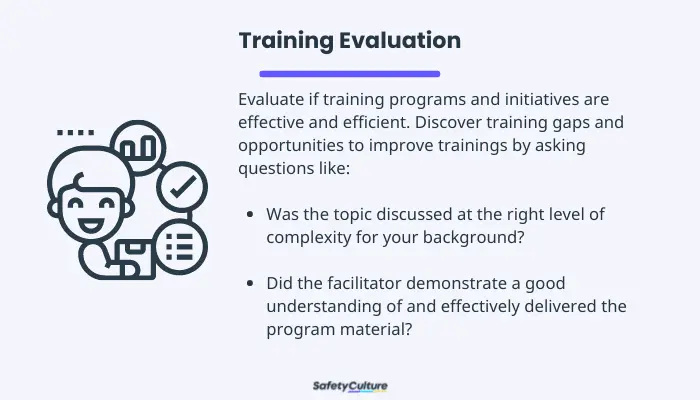What is Training Evaluation?
Training evaluation is the systematic process of analyzing training programs to ensure that it is delivered effectively and efficiently. Training evaluation identifies training gaps and even discovers opportunities for improving training programs.
By collecting feedback, trainers and human resource professionals are able to assess whether training programs are able to achieve its intended outcome, and if the training materials and resources used are aligned with or meet company and industry standards.
Training evaluation usually covers examining questions like “Was the topic discussed at the right level of complexity for your background?” and “Did the facilitator demonstrate a good understanding of and effectively delivered the program material?”, among others. This allows trainers to gain insight on what’s working and what’s not. Helping them to make better decisions on future training.

Training Evaluation | SafetyCulture
Benefits
Evaluation of training gives comprehensive feedback on the value of the training programs and their effectiveness in achieving business goals. It helps the management to better understand and identify skill gaps to analyze the desired outcomes of training programs. It also helps the organization to:
- identify issues and improve the overall processes of training programs;
- analyze the effectiveness of training materials and other tools;
- determine the needed leadership competencies to solve critical problems;
- support continuous change in career development; and
- assess the overall training experience of the participants.
How to Evaluate a Training Program in 4 Steps
Training evaluation is an important process in determining training effectiveness and in checking if training programs are indeed helping employees become good at what they do. Training evaluation can also be integrated as a feature of your learning management system.
Through strategic evaluation, businesses can find ways to improve the quality of training and achieve the learning goals set for employee success. To help you get started, we have listed down the training evaluation process in 4 steps:
1. Choosing the appropriate model
There are various types of training evaluation models available and each targets different areas. So the first step to getting started in evaluating training programs is by choosing the best model that will fit the needs of your evaluation.
Below are 3 of the commonly used training evaluation model:
Kirkpatrick’s Four-level Model
This training evaluation process is used globally by businesses that aim to get a return on investment (ROI) through cost-effective and time-efficient training sessions. This model breaks down the evaluation process into 4 levels:
- Level 1: Reaction – Assesses how the learner’s responded to the training. This is commonly measured with the use of a survey form given to the participants to complete after the training program.
- Level 2: Learning – This level measures what participants have learned from the training. Short quizzes and tests are used in this level to measure the changes in participant’s knowledge and skills.
- Level 3: Behavior – This assesses behavioral change from the participants as a result of training. This is measured through workplace observations, comparing before and after training behaviors.
- Level 4: Results – The final step measures and evaluates the result of the training program against the organization or stakeholder’s expectations. It reviews whether participants of the training have met their learning objectives. Some metrics or factors organizations will be measuring are productivity, morale, quality, sales, efficiency, and customer satisfaction ratings.
The CIRO Model
The CIRO (context, input, reaction, and output) model evaluates the effectiveness of management training courses. It focuses on measurements taken before and after carrying out the training program. Similar to the other models, the training evaluation process is also broken down to 4 stages:
- Stage 1: Context – This stage assesses the organization or business’s operational situation to identify and evaluate the training needs and objectives. In this stage, a training needs analysis is conducted to see which area of operations the organization is lacking. Once training needs are defined they are set to the following 3 levels:
- The ultimate objective – this objective aims to eliminate organizational deficiencies like poor performance, low profit, low productivity, or poor customer service.
- Intermediate objectives – these objectives require changes in employee’s work behavior in order to achieve the ultimate objective.
- Immediate objectives – these objectives involve acquiring new skills and knowledge and even changing employee attitudes to change their behavior.
- Stage 2: Input – In this stage, practitioners of the training evaluation gather information by analyzing available resources in the organization to determine the best choice of training technique or method to achieve training objectives.
- Stage 3: Reaction – In this stage, feedback from the participants is collected. The information gathered from this stage is used to further improve the training program.
Stage 4: Outcome – This stage evaluates the results of the training program. The outcome is measured on the following 4 levels:- The learner level
- The workplace level
- The team or department level
- The business level
Phillips ROI Model
The Phillips ROI model evaluates the training program’s return on investment (ROI). This model basically emulates the scope and sequence of the Kirkpatrick’s Model, but with an additional step. The five levels of the model are as follows:
- Level 1: Reaction – similar to the Kirkpatrick Model, the model starts with evaluating the participant’s reaction and satisfaction to the training program.
- Level 2: Learning – this level measures the skills and knowledge gained by the participants
- Level 3: Application and implementation – similar to the Kirkpatrick Model, this level measures whether the participants of the training program learned anything from training upon returning to the workplace. However, it improves that scope by determining whether an issue (if any) resides with the application of the learning or its implementation.
- Level 4: Impact – in the Phillips model, instead of results it focuses on measuring the overall business impact of the training program. It is much broader compared to Kirkpatrick’s model as it identifies whether other factors aside from training affected the outcome.
- Level 5: Return on investment (ROI) – This added level is designed to measure the ROI with the use of cost-benefit analysis to compare the monetary value of the business outcomes with the costs of the training program(s).
2. Determine indicators of training effectiveness
To effectively evaluate training programs, practitioners of the training program must first define the indicators of “effectiveness.” As a guide, practitioners or organizations should answer this guiding question: “In what sense will the training program be considered successful?”
Below are some examples of factors or indicators that can help in measuring training effectiveness:
- New skills and knowledge
- Learning experience
- Employee happiness
- Cultural impact
- Efficiency impact
- Financial impact
3. Choosing the right method and collecting data
Training evaluation methods refer to approaches in collecting the data. Once the training evaluation’s purpose, technique, and measurements for training effectiveness are identified, the next step is to choose the right method or tools for collecting the needed information in regards to the training program.
Below are some of the common training evaluation methods practitioners can use:
- Questionnaires – these are sets of questions commonly used for gathering statistical information from participants on a particular topic. This can be used as a tool when conducting surveys for trainees after the completion of the training program.
- Interviews – this can be conducted either face-to-face or online. This method allows practitioners to delve deeper into the responses of the participants. Interviews can help provide practitioners with more valuable and detailed information on the employee’s experience with the training.
- Focus groups – these are facilitated discussions among a small group of participants who underwent the same training program. This is helpful if the goal of the practitioners is to explore the participant’s insight and feelings towards the training and to gather some feedback on how the training can be improved.
- Observation – this method is done by observing the participant’s behavioral change in a workplace setting. The practitioner or assigned evaluator will observe how they complete tasks or engage with processes and team activities.
Once a method has been selected, practitioners can proceed with collecting the data.
4. Analyze Data
The final step is to analyze the data collected and to document the findings of the performed training evaluation. The record of the training evaluation will be a critical component for future improvements in the organization’s approach to training programs.
When is the Best Time to Evaluate Training?
Training evaluation should be tied to the purpose of assessment. It is measured against a range of expectations on when to notice the effectiveness of training for employees and the business. Consider time periods such as appraisal, adaptation, application, and achievement to map a process of what outcomes are to be expected at those levels.
Evaluation of training can be performed early, mid, or end of the year depending on the purpose of evaluation. Usually, early and mid-year evaluations are performed to shape the training program and the teaching approach. It helps address any issues and make improvements within the current program. While the annual evaluations measure the success of the training programs and the performance of the instructor. It is usually used for annual reviews, hiring, or promotion.
Create Your Own Training Evaluation Form
Eliminate manual tasks and streamline your operations.
Get started for FREEA Digital Tool to Improve Training Programs
Apart from having clear and comprehensive in place, it’s vital that they’re effectively communicated to your workers. This is where the need for training comes in.
With good training, you can reinforce the best practices outlined in your manuals and Standard Operating Procedures (SOPs) on how to effectively evaluate training programs for employees. On top of higher quality work and better productivity, it can also help your workers become more aware of job expectations, Key Performance Indicators (KPIs), and training goals.
Also, a digital training evaluation form can help trainers determine if the training programs are adequate to facilitate learning. With the help of SafetyCulture (formerly iAuditor), a cloud-based software with a Training feature, organizations can:
- create training materials on mobile devices anytime and anywhere;
- conduct training feedback surveys;
- assess training programs to address trainees’ learning needs;
- facilitate new hire training to prepare employees for their roles;
- share evaluation records to the learning and development teams; and
- observe trends and common responses via SafetyCulture Analytics.




